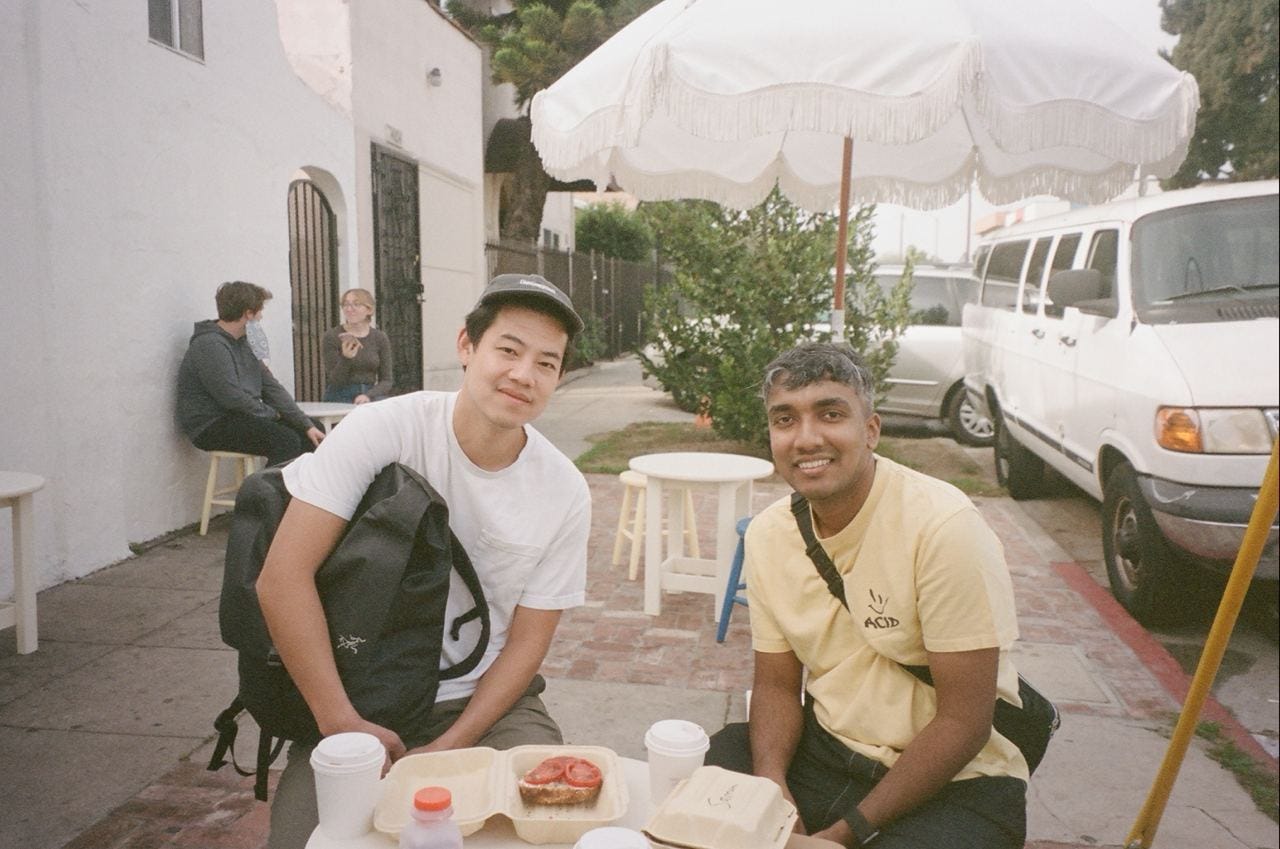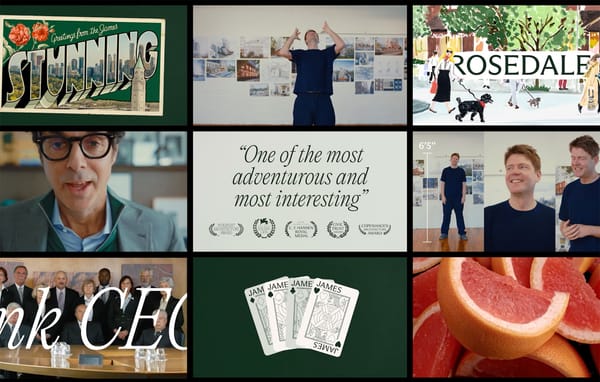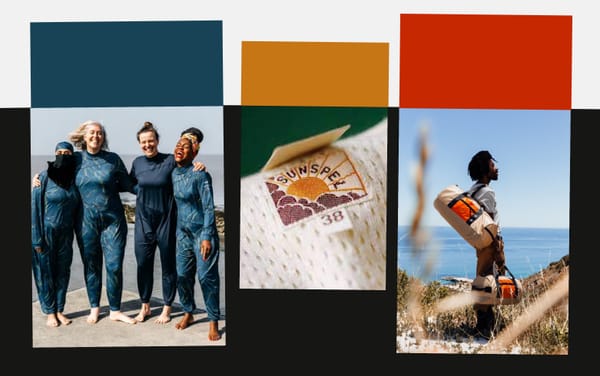Whole Self Catalog
Read.cv and the changing definitions of “career” and “team,” with Andy Chung

Hi everyone,
In 2021, after a decade working as a product designer and in design leadership at companies like Mozilla, Facebook, and Salesforce, Andy Chung launched Read.cv. It’s a professional network that caters to people with creative careers—and foregrounds the side projects, lectures, exhibitions, and other efforts that often come with them. In January, Chung and his colleagues launched Posts, a related social network. Design and attention to detail differentiate both products, which has naturally drawn both designers and early-adopting non-designers like me. I spoke with Chung on June 2 about the ideas behind the products, what a career looks like today, the value of design as companies scale, and the benefits of manual curation.
Love all ways,
Brian
BS: You describe Read.cv as a “show-don’t-tell professional network.” Can you tell me what you mean by that and how that phrase distinguishes what you do from other professional networks?
AC: The idea behind our platform is that, rather than listing out credentials—your work experience, your education at institutions—we encourage people to tell their stories around the tangible outcomes of their work. We’re a design-centric platform and we’re interested in sharing what people build themselves, what they contribute to larger projects, how people are using those things, and what other outcomes have arisen from those efforts. That’s different from saying, “I spent four years at this fancy school and I’m a great candidate.”
BS: Let me ask a related but broader question. What, to you, constitutes a person’s “professional life” today? How has that changed in the past decade or two and where do you think that concept is heading?
AC: There are so many ways to answer that: personally, as a founder, wider industry trends in design and tech …
BS: Let’s use your experience as a lens.
AC: To me, what it means to have a professional design practice has evolved over the past fifteen years. When I graduated from design school in 2009, the design career looked more like a linear path. You’d join an agency, work your way up from junior to senior designer and then shift into management. Or perhaps you’d break off and start your own design practice somewhere along the way.
There has been something of an existential shift recently, with more designers working in-house at larger tech companies and thinking about what a career path can look like. To be honest, I haven’t seen too many great answers. Lots of people still enter the field, work their way up the org chart as an individual contributor, then move into management. Then they’re ten years in and asking questions about finding more meaning in the work.
BS: You were at that point as well.
AC: I was at that point as well. Maybe it’s not a new problem, just a new context. Before, the hierarchy young designers faced was in a studio or agency setting. Maybe you felt like things were out of your hands if you weren’t a partner. Today that “existential crisis” is happening just as much inside the design departments of big tech companies.
But that also means the options open to designers are different. Before, perhaps you shifted into service design or some other discipline, or you went multidisciplinary. As I reflected on my own path, I gravitated toward having a design practice in which I could explore ideas independently. Rather than starting a studio, for me that looked like launching a startup.
BS: And that experience plays into how you’ve designed Read.cv.
AC: Yes. We’ve tried to build the platform with a bunch of what we call “flexible primitives”—the pieces you use to tell your professional story. We’re different from a platform like Dribbble, where you get a 4:3 thumbnail to represent a project. We try to recognize and value that there are many ways you can have impact: as a manager, as an individual contributor; your contribution could be specialized or general. Having flexible primitives enables people to tell nuanced stories about themselves.
BS: And since you’ve started a company, I wonder if you can talk about how the concept of a “team” is evolving, too. I ask in part because it’s easier than ever to hire contractors and work together remotely. With tools like Stripe Atlas and its ilk, it’s also easier than ever to start a company.
AC: The definitions depend largely on company size and what stage it’s at. I’ll answer based on the decisions we made with Read.cv and the landscape we entered. Other professional network–type startups that launched roughly when we did took a hard-line stance on the future of work. Some are positioned around a bet that the future of work is entirely freelance. Others believe that you’ll be making revenue through different channels—developing online content, doing podcasts, running courses. Yet others are still oriented around a world of full-time employment. We try to remain agnostic, so that both a freelancer and someone in year five of their current role can represent themselves in ways that satisfy them.
BS: And they’re doing that because they may, at some point, be open to finding new work. Companies are the other side of your marketplace, and Read.cv offers both team profiles and the ability to post jobs. What does success look like for companies that use the platform?
AC: Smaller companies often have less brand recognition. “We have five people on the team, few outsiders have heard of us. How do we get our name out there and get great candidates for our open roles?” Because we’re design-centric and try to be thoughtful, we’ve heard from candidates, especially designers, that finding a team on Read.cv is a litmus test for companies that care about design. And vice-versa: companies posting jobs have described getting a much higher signal-to-noise ratio in the applicant pool. It’s a benefit of being in something of a niche, for now.
BS: I’m drawn to Read.cv in part because of the front- and back-end polish: both of your products look beautiful and work smoothly. Can you talk about the value of design in small-scale enterprises? And how does that value change as an organization grows?
AC: We believe in the holistic definition of design—it’s not just how it looks, but also about implementation, how something works. On the website and in our apps, we try to make everything feel snappy, feel good. It’s a differentiator. If your product works ten percent better than a competitor’s, that’s a huge benefit.
Now, of course, lots of companies over-index on that. But design is a great wedge for entering into a market. You can attract a lot of designers by having greatly designed products. The challenge is then growing from there, balancing the desire to hit a certain quality level when you ship a feature with the need to get it out in a timely manner. These are perpetual trade-offs.
As for larger companies: if you’re a designer working in one, your job is to care about the user, care about quality, care about craftsmanship. Different companies have different incentives. I worked at Facebook and Salesforce and they were incredibly different experiences. As has become apparent in the past five to seven years, Facebook’s incentives are not necessarily aligned with its users. And as a designer, it’s challenging when your values seem to run against a culture of optimization at all costs. At Quip [which Salesforce acquired in 2016–ed.], the incentives felt more aligned. The more useful we made the product, the easier it was to sell. That alignment was pretty refreshing, to be honest.

BS: I mentioned “both of your products” but haven’t asked about the newest, a “community app” called Posts.cv. You state explicitly that the “biggest problem we’re solving for is community, not design or engineering.” That’s a huge challenge, and not one that has heretofore been solved through engineering or design alone, especially at scale. Can you talk about the incentive to launch what is, essentially, a social network?
AC: Read.cv has always had a profile maker, a way to make a little personal website, with some light social stuff integrated. But it wasn’t a social network in any traditional sense. It was a single-player experience. And we found that many people create their pages and leave. They “set it and forget it” until it’s time to update their profile. Of course we want people to be more deeply engaged with the platform: to see what everyone else is up to, or to see open roles.
We had been close to having the social thing going on, but not quite—and people kept asking us if we’d create one. I was hesitant because of Twitter, which I’ve used for fifteen years. It’s a huge incumbent and it worked—I’ve made friends and even found jobs through Twitter.
Then Elon took over and cracks started to form. In November, I began talking with my partner Mehdi about the chance that people might desire to move elsewhere. We realized that we had a strong foundation for building something that might be a destination for our people, to solve some of the issues that Twitter is having.
But we didn’t set out to clone the platform one-for-one. We would sooner compare posts to LinkedIn than to Twitter. It’s not pseudonymous, we’re not all about “free speech” (however that gets defined). We wanted to create a low-key place to interact, connect, and find opportunities. It’s a long-shot bet. But it’s also not every day that incumbents show cracks like this.
BS: And you aren’t the only one taking this long-shot bet.
AC: Not at all. It’s been interesting rolling Posts out as other companies, like Substack, have done something similar. And it’s been interesting to observe the vibes on each one.
BS: How would you characterize the vibe of Posts?
AC: I’m pleasantly surprised! One decision we made was to let people have access to an “Everyone” feed—a firehose of content. We were worried it’d be filled with junk, stuff we’d have to moderate. But it’s consistently high-quality; I don’t think I’ve had to delete more than one or two posts in the first few months. I pretty much only read the “Everyone” feed, and it’s a consistent source of interesting content and inspiration. That’s the biggest surprise.
BS: What do you attribute that to?
AC: We’ve been fortunate to attract a high-quality community. That translates from Read.cv to Posts. But we’ve also deliberately done one thing differently than other platforms: our “Highlights” feed is manually curated. The tone that is being set for the platform, the content people see first on Posts, is very intentional. It’s all hand-picked. It’s the same for the Read.cv homepage. Not letting an algorithm make those choices goes a long way toward setting the tone.
BS: And is also increasingly difficult to do as you grow. Perhaps we can end with a little discussion about your vision for the company and its products.
AC: Any successful platform breaks from its niche and grows branches. We’d love to have that happen. But we also want to make sure the operating metaphor remains “café in the center of the city.” It’s a private business, a privately owned platform, and if you come into the café to spout a bunch of racist stuff we’re going to remove you.
We want Read.cv and Posts to be as big and successful as possible. But we’re not fueled by the same kind of incentives as many other platforms. We raised a seed round, but we’re not fueled by the same growth imperatives as other VC-backed startups. We’re not pumping our money into user acquisition and advertising in order to make it to Series A, then Series B. We’re growing organically so our platform can continue feel the way it does. Our team is two full-timers and someone working part-time; we haven’t gone on a hiring spree, and the idea of this becoming a sustainable business is a lot more realistic because of that.
Going back to what you said earlier about tools and the future of companies: today the tooling is so good that you can launch a Twitter competitor with two people. So we did.
🔗 Good links
- 🏛️ This conversation between Studio Museum director Thelma Golden and New Museum director Lisa Phillips pairs nicely with yesterday’s New York Times piece asking, “What does it take to run a museum?”
- 📸 “I pointed my camera at things that were covered and could not be seen clearly.” A smart half-hour documentary about photographer Thomas Struth.
- 🟦 Thirty years after its release, artists reflect on Blue, Derek Jarman’s last feature film
- 🚲 I bought a new bike yesterday. I promise to not ride it like these amazing Vietnamese bikers.





